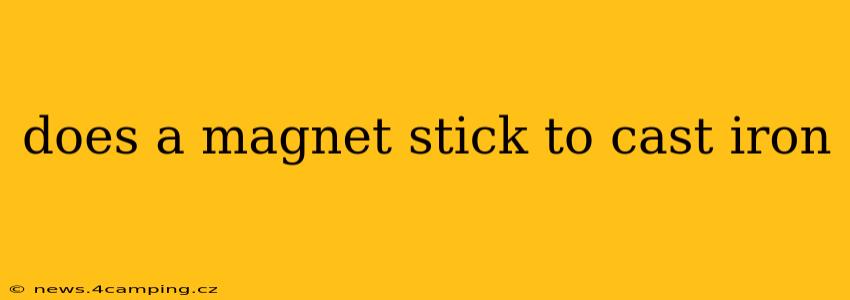Does a Magnet Stick to Cast Iron? A Comprehensive Guide
Yes, a magnet generally will stick to cast iron. This is because cast iron is a ferrous material, meaning it contains iron and is therefore magnetically susceptible. However, the strength of the magnetic attraction can vary depending on several factors, which we'll explore in detail below.
This seemingly simple question opens up a fascinating exploration into the world of magnetism and material science. Let's delve deeper into the nuances of why cast iron reacts to magnets and the circumstances under which it might not.
Why does a magnet stick to cast iron?
Cast iron's magnetic properties stem from its high iron content. Iron atoms possess unpaired electrons, creating a magnetic moment. In cast iron, these moments align in regions called magnetic domains. While these domains are randomly oriented in unmagnetized cast iron, the presence of a strong external magnetic field (like that of a magnet) can align these domains, leading to a temporary magnetic attraction. This is why the magnet sticks. The strength of the attraction depends on the size and strength of the magnet, the amount of iron in the cast iron, and the overall structure of the material.
What factors affect the strength of the magnetic attraction?
Several factors influence how strongly a magnet adheres to a piece of cast iron:
-
The strength of the magnet: A stronger magnet will naturally exert a more powerful pull. Neodymium magnets, for example, are significantly stronger than ceramic magnets.
-
The composition of the cast iron: Cast iron isn't a homogenous material. Variations in the iron content, as well as the presence of other elements like carbon, silicon, and manganese, can affect its magnetic susceptibility. Higher iron content generally leads to stronger magnetic attraction.
-
The size and shape of the cast iron: A larger piece of cast iron will generally attract a magnet more strongly simply due to the larger surface area and amount of iron involved. The shape also matters; a thick, solid piece will generally be more magnetic than a thin, intricate casting.
-
The presence of coatings or other materials: If the cast iron is coated with paint, rust, or other non-magnetic materials, this can significantly weaken or even prevent magnetic attraction. The magnet needs direct contact with the iron to be effective.
-
Temperature: Extreme temperatures can affect the magnetic properties of iron. Very high temperatures can cause a decrease in magnetism, while extremely low temperatures can increase it, but these changes are typically not significant in everyday scenarios.
What types of cast iron are most magnetic?
Generally speaking, all types of cast iron exhibit some degree of magnetism. However, the specific alloying elements and the manufacturing process can influence the final magnetic properties. Higher-carbon cast irons might show slightly weaker magnetism compared to lower-carbon variants, but the difference is usually subtle in everyday applications.
Are there instances where a magnet won't stick to cast iron?
While uncommon, there are scenarios where a magnet might not stick to cast iron:
-
Extremely thin castings: If the cast iron is exceptionally thin, the magnetic effect might be too weak to notice.
-
Significant surface coatings: A thick layer of paint, rust, or other non-magnetic materials can completely prevent the magnet from making contact with the iron.
-
Specific alloy compositions: In extremely rare cases, unusual alloying elements in the cast iron could significantly reduce its magnetic properties. This would likely be a highly specialized or unusual type of cast iron.
In conclusion, while a magnet will generally stick to cast iron due to its ferrous nature, the strength of the attraction depends on multiple factors. Understanding these factors helps explain why sometimes the magnetic interaction might seem weaker or even absent.
